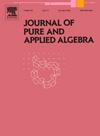The multiple holomorph of centerless groups
IF 0.7
2区 数学
Q2 MATHEMATICS
引用次数: 0
Abstract
Let G be a group. The holomorph of G may be defined as the normalizer of the subgroup of either left or right translations in the group of all permutations of G. The multiple holomorph is in turn defined as the normalizer of the holomorph. Their quotient has been computed for various families of groups G. In this paper, we consider the case when G is centerless, and we show that must have exponent at most 2 unless G satisfies some fairly strong conditions. As applications of our main theorem, we are able to show that has order 2 for all almost simple groups G, and that has exponent at most 2 for all centerless perfect or complete groups G.
求助全文
约1分钟内获得全文
求助全文
来源期刊
CiteScore
1.70
自引率
12.50%
发文量
225
审稿时长
17 days
期刊介绍:
The Journal of Pure and Applied Algebra concentrates on that part of algebra likely to be of general mathematical interest: algebraic results with immediate applications, and the development of algebraic theories of sufficiently general relevance to allow for future applications.

 求助内容:
求助内容: 应助结果提醒方式:
应助结果提醒方式:


